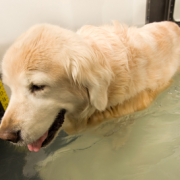
AJ Debiasse, a technician in Stroudsburg, PA, contributed to this article.
Like people, dogs can benefit from physical therapy or rehabilitation. There are multiple reasons why a dog might need this:
- The dog is recovering from surgery
- The dog has soft tissue injuries
- The dog has arthritis
- The dog has neurological diseases
Any pet of any age might need physical therapy.
How do you know your dog needs physical therapy?
As your dog ages, you may notice subtle changes at home. They may include:
- Difficulty getting up after a nap
- Hesitation on stairs
- Reluctance to go for walks
- Only tolerating shorter distances
- Evidence of pain such as vocalization, decreased appetite or longer naps
It's is important to confirm that there is nothing more severe going on. Most rehab veterinarians will require a referral from your family vet stating that rehab is recommended and your dog is healthy enough to do so. A full, physical exam, with diagnostics such as blood work and radiographs can help confirm that there is nothing more serious going on.
How does physical therapy work for dogs?
Rehab in a dog can involve multiple pieces of equipment or “modalities” as we call them. Let’s go over half a dozen common modalities.
1. Passive range of motion (PROM) exercises mean that someone manually helps your dog move a joint back and forth, mimicking its normal motion to improve flexibility. The most common exercise is what we call the “bicycle” motion.
2. Heat and cold therapy go hand-in-hand with PROM. Using warmth before the exercises prepares the muscles for activity. Using ice after physical therapy helps reduce inflammation and pain. It is very important to always have a barrier between your pet’s skin and the heat/ice source to protect the skin. It can be as simple as a thin towel.
3. An underwater treadmill is a special treadmill that is enclosed in a watertight container. Different levels of water can be added. The higher the water level, the less of the pet’s body weight is carried. The rehab vet would typically start out with a high water level and a slow speed for a short amount of time; then, gradually increase the difficulty by decreasing the water level and increasing the speed and duration of activity.
4. An obstacle type course can also be used to help your dog increase or relearn balance and paw placement. This can include the use of hills, steps, ramps, bars, balance balls, etc.
5. Therapeutic ultrasound uses ultrasonic waves to stimulate muscle activity. These waves are different from what we use to look inside a dog’s belly. Therapeutic ultrasound provides heat to muscles, tendons and ligaments and can help heal them.
6. A cold therapy laser works at the level of cells in the body. It can decrease inflammation and increase circulation, which can help decrease pain and increase healing. Cold therapy laser should not be used if cancer is suspected, as it can encourage cancer growth.
Are there any risks to physical therapy?
Physical therapy, although considered very safe, can have complications. If done improperly, you may see no improvement or even a worsening. Physical therapy, even if done correctly, can be uncomfortable, so it's extremely important to control your dog’s pain level.
As long as it’s done correctly and your dog’s pain is under control, physical therapy is a great and safe way to help with recovery and improve quality of life.
If you have any questions or concerns, you should always visit or call your veterinarian -- they are your best resource to ensure the health and well-being of your pets.
